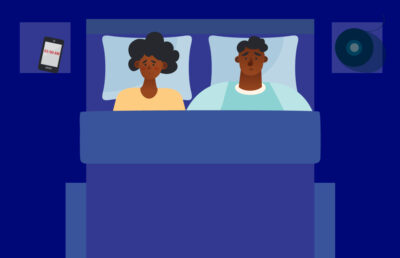At Sleepopolis, we’re constantly monitoring new sleep health developments in order to keep our articles as up-to-date and accurate as possible.
A Comprehensive Guide to Narcolepsy
- by Sharon Brandwein
- Updated: November 8, 2023
Table of Contents

Written by Sharon Brandwein, Writer
Methodology
Just Updated
This article has been updated to reflect more recent medical consensus around narcolepsy and pregnancy.
While narcolepsy provides endless fodder for jokes in TV, movies, and real life, it’s actually a pretty serious sleep disorder. Hallmarks of the condition are an uncontrollable urge to sleep — often at inappropriate times — and an involuntary loss of muscle tone, to name a few. Narcolepsy is far more complicated than simply being tired; it’s a chronic condition that can exact a heavy toll on daily life for those who suffer from it.
Note: The content on Sleepopolis is meant to be informative in nature, but it shouldn’t be taken as medical advice, and it shouldn’t take the place of medical advice and supervision from a trained professional. If you feel you may be suffering from any sleep disorder or medical condition, please see your healthcare provider immediately.

Long Story Short
- Narcolepsy is a chronic neurological disorder with symptoms like excessive daytime sleepiness, muscle weakness, and fragmented sleep.
- Doctors typically rely on sleep studies and multiple sleep latency tests to make an accurate narcolepsy diagnosis.
- The sleep disorder is treatable with medication and improved sleep hygiene.
What Is Narcolepsy?
Dr. Chester Wu, a double board-certified doctor in Psychiatry and Sleep Medicine, tells Sleepopolis, “Narcolepsy is a chronic neurological disorder characterized by excessive daytime sleepiness, cataplexy (muscle weakness), and disrupted nighttime sleep.”
Narcolepsy is far more than just being tired or having the assumed ability to fall asleep quickly. It’s a chronic neurological disorder that disrupts the brain’s ability to control your sleep-wake cycles. (1) Symptoms of narcolepsy often begin in childhood or young adulthood, but most people are diagnosed somewhere between the ages of 20 and 40. (2)
Narcolepsy isn’t contagious or harmful to your health, but falling asleep can be dangerous in some circumstances, such as while driving. Wu adds that it’s impossible to control one’s overwhelming sleepiness, so the condition can be debilitating and have a significant impact on daily life.
Narcolepsy Types
There are two types of narcolepsy. “Type 1 is also known as narcolepsy with cataplexy (temporary, sudden muscle weakness that might have you slurring your words or collapsing). Type 2 narcolepsy is also known as narcolepsy without cataplexy,” says Wu, adding, “Type 2 narcolepsy is much more common.” (1)
Type 1 Narcolepsy (NT1)
Individuals with type 1 narcolepsy (NT1) experience episodes of extreme sleepiness along with cataplexy (sudden muscle weakness). On top of excessive daytime sleepiness and cataplexy, individuals with type 1 narcolepsy are also deficient in hypocretin — a neuropeptide (brain chemical) that plays a key role in maintaining wakefulness. (3)
Type 2 Narcolepsy (NT2)
Individuals with type 2 narcolepsy (NT2) experience similar episodes of extreme sleepiness; however, there is no cataplexy, and their hypocretin levels are typically within normal ranges.
How Common Is Narcolepsy?
Narcolepsy is a relatively rare but chronic condition affecting about 1 in every 2,000 Americans. (4) Worldwide, researchers estimate that narcolepsy affects about 1.21 percent of the population. It’s important to note that these numbers are estimates, as narcolepsy is notoriously under-reported or undiagnosed. Narcolepsy affects men and women equally. (1)
Narcolepsy and Children
“Narcolepsy can begin in childhood, but it’s often underdiagnosed,” says Wu. (5) “Symptoms in children may be similar to adults but can also include behavioral and learning problems. It’s not uncommon for narcolepsy to be mistaken for ADHD or other psychiatric or emotional disorders.”
What Causes Narcolepsy?
While Wu says that the exact cause of narcolepsy isn’t fully understood, he notes that its “causes may involve genetic factors, an autoimmune reaction that affects hypocretin/orexin-producing neurons (type 1 may arise from a lack of orexin in the brain), brain trauma, and certain environmental triggers (such as stress, hormonal changes, and infections).”(1)
Narcolepsy Symptoms
The symptoms of narcolepsy persist throughout a lifetime. And while they may not resolve completely, those diagnosed with the disorder may take heart in the fact that they don’t worsen over time.
“Excessive daytime sleepiness, sleep attacks (falling asleep randomly), parasomnias like sleep paralysis and hallucinations, and fragmented sleep are all common symptoms,” says Wu. (6) And while he tells us that excessive daytime sleepiness is a universal symptom, he notes that not all patients experience all symptoms.
Excessive and Persistent Daytime Sleepiness
Excessive daytime sleepiness is by far the most recognizable (and probably the most problematic) symptom of narcolepsy. (6) And just as it sounds, it’s a profound feeling of sleepiness. While people with narcolepsy may wake up feeling well-rested, they’re likely to battle an irresistible urge to sleep throughout the day, which frequently leads to sleep attacks.
Sleep attacks are episodes where a person with narcolepsy falls into a deep sleep. Attacks are quite sudden and tend to occur at inappropriate times. Sleep attacks have been known to occur mid-conversation, during a meal or meeting, and as alarming as it sounds, they’ve even been known to happen while driving. Sleep attacks typically last from a few minutes to a few seconds, and the sleeper often wakes up refreshed.
Cataplexy
Cataplexy, or the sudden loss of muscle tone or muscle weakness in a wakeful state, is another symptom of narcolepsy, but it is limited to NT1. (6) Cataplexy is often sparked by a surge of strong emotions. Stress, fear, anger, and even happiness and laughter can trigger cataplexy. (7)
Episodes of cataplexy can range from mild (i.e., drooping eyelids, dropping one’s head, or a slackening of the jaw) to severe (knee-buckling, a total body collapse, or temporary paralysis). In cases of severe cataplexy, it’s important to know that while the person may be unable to move, speak or keep their eyes open, they are still conscious. (7)
The frequency of cataplexy episodes tends to vary from person to person. While some people with narcolepsy may experience just a few episodes of cataplexy over their lifetime, others may have several episodes in one day. A typical cataplexy episode lasts for about two minutes. (7)
From the outside looking in, cataplexy episodes can be unsettling and even scary, but aside from sustaining a physical injury during an episode (falling, hitting a head, etc.), cataplexy on its own doesn’t cause any long-term harm to the person experiencing it.
Sleep Paralysis
Sleep paralysis is the inability to move or speak. (6) These episodes are temporary, lasting anywhere from a few seconds to a few minutes, and they typically occur during sleep transitions — when someone is falling asleep or during the arousal process. While sleep paralysis closely mimics REM sleep muscle paralysis, it’s important to note that the person experiencing it is conscious.
Hallucinations
Hallucinations often occur alongside sleep paralysis for people with narcolepsy and are therefore considered another symptom of the disorder. Hallucinations associated with narcolepsy fall into two categories, hypnogogic and hypnopompic. Hypnogogic hallucinations occur just as the person falls asleep, while hypnopompic hallucinations tend to occur as they wake up. (8)
Fragmented Sleep
Sleeping through the night is a challenge for most people with narcolepsy. For those with the disorder, fragmented sleep is marked by frequent waking for 10 to 20 minutes at a time. And as you might have guessed, fragmented sleep only exacerbates the symptoms of excessive daytime sleepiness. (8)
Automatic Behavior
Another symptom of narcolepsy (and a pretty interesting one) is automatic behavior. Essentially, when a person with narcolepsy suddenly falls asleep while walking, talking, eating, or driving, they may automatically carry on with said activity for a few seconds. In some cases, automatic behavior can go on for a few minutes. (1)
The individual is usually unaware of their activity, and those around them will likely note a marked difference in their performance. For example, handwriting becomes illegible, and someone driving would likely cause an accident. People with narcolepsy don’t usually recall their actions and typically wake from the episodes feeling refreshed. (1)
Effects of Narcolepsy
Narcolepsy can have a profound impact on the daily lives of those diagnosed (or not diagnosed) with the disorder. Excessive daytime sleepiness, uncontrollable loss of muscle tone, and random sleep attacks will most certainly present unique challenges — not only to the individual but also to the people around them. Narcolepsy may be embarrassing and problematic in work and social situations, but it can also be downright dangerous in others.
How Is Narcolepsy Diagnosed?
“Narcolepsy can feel like insomnia, so many people with the disorder might not even realize they have it,” says Wu. “Diagnosis typically requires a sleep physician to perform a sleep study (PSG) along with some daytime testing or a multiple sleep latency test (MLST).”
Sleep Diary
In many cases, a narcolepsy diagnosis may begin with a sleep diary. Very often, doctors will ask the patient to keep a record of their sleep habits (with input from bed partners, if applicable). Sleep diaries can be a helpful starting point as they typically document the time you go to bed, the hour you wake up, and any disruptions in between. Those keeping a sleep diary should also note how they feel in the morning upon waking and during the day.
Polysomnogram
The next step on your road to a diagnosis may be a sleep study or a polysomnogram. Usually conducted over one or more nights in a clinical sleep lab, polysomnograms allow sleep techs to observe your sleep patterns and rule out other sleep disorders like sleep apnea. When looking for narcolepsy, sleep technicians will look for signs of the disorder, like fragmented sleep and excessive daytime sleepiness. (6)
Multiple Sleep Latency Tests (MSLT)
While sleepers who don’t have narcolepsy can take anywhere from 90 minutes to 2 hours to enter REM sleep, people with narcolepsy tend to enter REM sleep quickly. In fact, it’s not uncommon for people with narcolepsy to reach REM sleep in as little as 15 minutes after falling asleep. (1)
A multiple sleep latency test is often referred to as the gold standard for diagnosing narcolepsy. Typically scheduled as a series of 5 naps spread throughout the day, MSLTs can accurately assess how long it takes you to fall asleep and how quickly you enter REM sleep. (6)
Spinal Tap
While the MSLT is the go-to for diagnosing narcolepsy, there is some evidence to suggest that it may not always be reliable. If questions remain following an MSLT, your doctor may recommend a spinal tap to measure hypocretin levels — remember, low hypocretin levels are a hallmark of type 1 narcolepsy. Spinal taps should be done in conjunction with the MSLT (not in place of it) as they’re not suitable as a stand-alone diagnostic tool for narcolepsy. (9)
Narcolepsy Treatments
There’s no cure for narcolepsy, but the condition can be managed with a combination of drug therapies and behavioral changes.
Behavioral Changes
Wu notes that “behavioral strategies like scheduled short naps and good sleep hygiene (especially a regular sleep schedule and avoiding sleep disruptors like caffeine and alcohol) can also be helpful.”
Medications
Wu tells us that the most effective treatment for narcolepsy is usually a combination of medications. “Stimulants like modafinil or Adderall can combat daytime sleepiness, while antidepressants are used to control cataplexy and parasomnias. Additionally, sodium oxybate can help with sleep consolidation at night and address other symptoms like daytime sleepiness and cataplexy,” he says. (6)
Narcolepsy and Pregnancy
Wu says symptoms of narcolepsy may be exacerbated by the hormonal changes, fatigue, and stress of pregnancy. He adds that cataplexy, which can be triggered by stress or strong emotions, can be more common during pregnancy as well.
Wu recommends women work closely with their obstetrician and sleep doctor to review and adjust their narcolepsy treatment plans as needed. “Close monitoring and coordination between healthcare providers can make sure that the pregnant woman is getting the best possible care for both herself and her baby,” he says.
Until recently, the general medical consensus was that women with narcolepsy should stop using their medication. However, that viewpoint has since shifted a bit. (10)
Ultimately, everybody’s pregnancy is different, so if you have questions about your treatment plan during pregnancy, talk to your doctor. They may recommend staying on your medication while pregnant or going off it. What’s right for you may not be right for someone else and vice-versa, but your care team will work with you to develop the plan that’s right for your medical needs and lifestyle.
Emotional Support for People with Narcolpesy
Though more research is needed to understand the causes, we know that anxiety, depression, and other psychiatric conditions often occur in patients with narcolepsy. (11) “Narcolepsy can be a challenging condition to live with and can often be misunderstood, stigmatized, and isolating. Support from friends, family, and healthcare providers can help improve quality of life,” says Wu.
He explains that the emotional support each individual needs may vary, but for most people, having a better understanding of the condition and talking with their sleep doctor can make a difference. Wake Up Narcolepsy, Project Sleep, and Narcolepsy Network are three organizations that provide valuable resources, support groups, and research updates to patients and family members of people with narcolepsy. For people who are seeking more individualized support, Wu recommends seeking out a therapist.
When to See a Doctor
Narcolepsy may be the punchline for jokes, but it’s no laughing matter. It’s a serious chronic condition, but one that can be treated with medication and behavioral changes. If you think you may have narcolepsy or suspect that a loved one does, it’s imperative to see a doctor immediately.
FAQs
When does narcolepsy develop?
Symptoms of narcolepsy often begin in childhood or young adulthood, but for many people diagnosis often comes much later, between the ages of 20 and 40.
How many people have narcolepsy?
Narcolepsy is a relatively rare but chronic condition affecting about 1 in every 2,000 Americans. Worldwide, researchers estimate that narcolepsy affects about 1.21 percent of the population.
What triggers narcolepsy?
While doctors and researchers have yet to pinpoint the exact cause of narcolepsy, it’s believed that genetic factors, low levels of the neuropeptide, hypocretin, brain trauma, and certain environmental triggers like stress, hormonal changes, and infections may trigger the sleep disorder.
The Last Word From Sleepopolis
Narcolepsy is a lifelong chronic condition. In addition to the disruption to sleep health and daily life, those with moderate to severe narcolepsy symptoms may also find the condition to be dangerous from time to time. While there is no cure for narcolepsy, drug therapy, lifestyle changes, and good sleep hygiene can help you manage its impact.
Sources
- U.S. Department of Health and Human Services. (n.d.). Narcolepsy. National Institute of Neurological Disorders and Stroke. https://www.ninds.nih.gov/health-information/disorders/narcolepsy#
- NHS. (n.d.). NHS choices. https://www.nhs.uk/conditions/narcolepsy/
- Emmanuel Mignot, Jamie Zeitzer, Fabio Pizza, Giuseppe Plazzi, 2021. “Sleep Problems in Narcolepsy and the Role of Hypocretin/Orexin Deficiency”, The Orexin System. Basic Science and Role in Sleep Pathology, Michel A. Steiner, Masashi Yanagisawa, Martine Clozel
- Center for Narcolepsy. (n.d.). Our mission. Center for Narcolepsy. https://med.stanford.edu/narcolepsy.html
- Correlates to problem behaviors in pediatric narcolepsy: A pilot study … (n.d.-a). https://jcsm.aasm.org/doi/10.5664/jcsm.6842
- Slowik JM, Collen JF, Yow AG. Narcolepsy. [Updated 2022 Jun 21]. In: StatPearls [Internet]. Treasure Island (FL): StatPearls Publishing; 2024 Jan-. Available from: https://www.ncbi.nlm.nih.gov/books/NBK459236/
- Mirabile VS, Sharma S. Cataplexy. [Updated 2024 Apr 15]. In: StatPearls [Internet]. Treasure Island (FL): StatPearls Publishing; 2024 Jan-. Available from: https://www.ncbi.nlm.nih.gov/books/NBK549782/
- Symptoms of narcolepsy. Sleep Medicine. (n.d.-b). https://sleep.hms.harvard.edu/education-training/public-education/sleep-and-health-education-program/sleep-health-education-3
- Agata Gabryelska a b, a, b, c, Highlights•The MSLT is not always a reliable diagnostic test for narcolepsy.•CSF hypocretin-1 concentrations can be useful in diagnosing narcolepsy.•CSF-hypocretin-1 level can be low in psychiatric disorders., & AbstractObjectivesThe patho-aetiology of narcolepsy Type I (NT1) is the loss of hypocretin-1 secreting neurons in the hypothalamus. Diagnostic criteria for NT1 include excessive daytime sleepiness (EDS) for at least three months not explained by any other. (2020, March 21). Utility of measuring CSF hypocretin-1 level in patients with suspected narcolepsy. Sleep Medicine. https://www.sciencedirect.com/science/article/abs/pii/S1389945720301210
- Jeremias, S. (2022, July 1). The challenges of living with narcolepsy while pregnant and how providers can help. AJMC. https://www.ajmc.com/view/the-challenges-of-living-with-narcolepsy-while-pregnant-and-how-providers-can-help
- 1.Abenza-Abildúa MJ, Suárez-Gisbert E, Lores-Gutiérrez V, et al. Anxiety and depression in patients with narcolepsy. Journal of Sleep Research. 2022;32(4). doi:https://doi.org/10.1111/jsr.13812
- Wu, Chester. Personal Interview. September 5, 2024.
Subscribe Today!
Get the latest deals, discounts, reviews, and giveaways!



